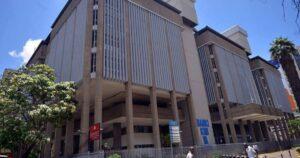- Central Bank of Kenya data shows that Kenya’s banking sector assets grew by double-digits in 2021, owing to growth in the purchase of government securities
- The Kenya Financial Sector Stability Report shows that loans and advances (net) as a share of net assets declined to 48.5 per cent in 2021 from 49.2 per cent in 2020
- Investment in government securities grew at a faster pace compared to growth in loans and advances between 2021 and 2020
A new report by the Central Bank of Kenya shows that Kenya’s banking sector assets grew by double-digits in 2021 because of the increased purchase of government securities.
According to the Kenya Financial Sector Stability Report, loans and advances (net) as a share of net assets declined to 48.5 per cent in 2021 from 49.2 per cent in 2020. At the same time, government securities holding increased to 30.5 per cent in December 2021 from 29.6 per cent in December 2020.
Investment in government securities grew at a faster pace compared to growth in loans and advances between 2021 and 2020.
Bank assets were mainly funded by customer deposits, which grew by 11.0 per cent in 2021. The microfinance banks recorded improved performance in 2021 compared with 2020 but are still weak and vulnerable to shocks.
Further, the report noted that banks’ net assets grew by 11.4 per cent in 2021 because of faster growth in purchasing government securities.
Total assets increased to KSh 6,022.1 billion in December 2021 from KSh 5,405.7 billion in December 2020. Since the fourth quarter of 2015, the growth in government securities has outpaced the loans and advances, indicating
that banks may be derisking by slowing down lending to the private sector.
The period was characterised by the 2015/2016 banking crisis and the restrictive interest rates capping law.
A correction towards the end of 2019 following repeal of the interest rates capping law was eroded by COVID–19 pandemic.
Banks’ flight to quality and safety tendencies during the pandemic was reflected in the increased holding of Government securities, more foreign currency denominated assets, and increased lending to large firms as credit risk increased.
Customer deposits grew by 11.0 per cent, to KSh 4,451.7 billion in December 2021 from KSh 4,011.3 billion
in December 2020, partly reflecting customers’ intent to preserve liquidity and enhanced efforts towards deposit mobilisation mainly through digital channels.
The CBK report also noted that the sector remained stable and resilient to the COVID-19 shock because of strong capital and liquidity buffers, supported by monetary and financial policies in 2020.
Overall, the sector’s core and total capital increased to KSh.750.5 billion and KSh.883.4 billion in December 2021, from KSh.686.7 billion and KSh.786.2 billion, respectively, in December 2020.
The strong capital growth is mainly due to 16.0 per cent growth in retained earnings following strong profitability.

Consequently, Core Capital and Total Capital to Total Risk-Weighted Assets (TRWA) ratios stood at 16.6 per cent and 19.5 per cent in December 2021, from 16.6 per cent and 19.0 per cent in December 2020.
These were above the minimum statutory core and total capital requirements of 10.5 per cent and 14.5 per cent, respectively.
However, growth in capital was mainly by banks in the large peer group, while capital for small and medium sized banks decreased, reflecting low profitability.
Credit risk remained elevated in 2021 as it was in 2020. The ratio of nonperforming loans to gross loans (NPLs) was 14.1 per cent in December 2021 same as the level of December 2020.
The actual NPLs recorded an annual increase of 5.5 per cent, to KSh 460.0 billion in December 2021, from KSh 436.1 billion in December 2020.
However, the contribution of performing loans relative to the NPLs grew faster by 8.2 per cent.
As a result, the NPLs ratio remained at 14.1 per cent as at December 2021 and in December 2020. Performing loans relative to NPLs, grew faster by, 8. (Canada pharmacy) 2 per cent, leaving the NPLs ratio at 14.1 per cent in December 2021, the same level in December 2020.
Financial policy measures implemented to mitigate the impact of the COVID-19 pandemic on banks and borrowers proved key to achieving and maintaining banking sector stability.
Measures, such as loan restructuring, the extension of loan repayment periods, and flexibility in loan classification explain the high-performing loan component in 2020 as compared to 2021. When these policies were unwound, NPLs ratio rose to 14.7 per cent in June 2022, signifying an elevated credit risk outlook in 2022.